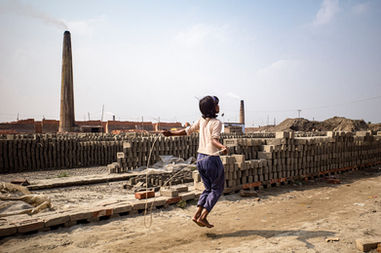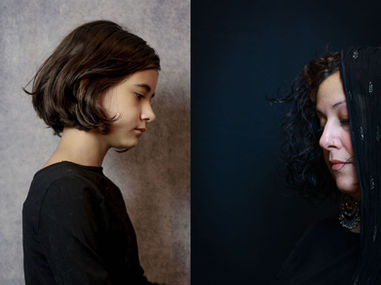
PICTORIAL STORY
November 22, 2024
BEYOND THE BRICKS
Stories of Hope and Resilience in Bangladesh
Photography and story by Anwar Ehtesham
Introduction by Karen Ghostlaw Pomarico
Amid Bangladesh’s dynamic urban growth, Anwar Ehtesham’s photography takes us beyond statistics and headlines, revealing the hidden lives of the laborers working tirelessly in the nation’s brick kilns. His photographs introduce us to the human faces behind the bricks that shape Bangladesh’s cityscapes, bringing forward stories of resilience that often go untold amidst industrial expansion. Anwar’s lens doesn’t merely document; it creates a bridge, allowing us to connect with the dignity, strength, and spirit of these often-overlooked workers, inviting us to witness their lives and contributions firsthand.
Anwar’s portrayal dives deeper than the environmental costs associated with brick production, instead celebrating the unyielding spirit of the workers who keep the wheels of progress turning. His journey into photography since 2020 has been fueled by an insatiable curiosity, a willingness to learn, and a steadfast commitment to portraying his subjects with authenticity and respect. Every image and encounter in this project reflect his dedication to visual storytelling — he does not simply observe but becomes part of the story, honoring the individuals he documents with a sensitivity that invites viewers to connect with their lives.
In every photograph we see the pride, generosity, and fortitude that defines the spirit of Bangladesh. Anwar’s work stands as a testament to the quiet strength of these laborers, urging us to recognize their contributions. His journey has been one of resilience and humility, capturing stories that honor the lives of those building the foundations of Bangladesh’s future. This feature invites readers to witness these moments, reminding us that true beauty lies in resilience, kindness, and the unwavering spirit of community.
-min.jpg)
In the heart of Bangladesh, amidst the bustling energy of progress, lies the untold story of the resilient workers toiling in the brick fields. As one of the most densely populated countries globally, Bangladesh is undergoing a surge in construction and urbanization, particularly in the housing and communication sectors, demanding a substantial brick supply. With over 7,000 brick kilns scattered across the landscape, contributing around 1% to the nation's GDP and providing livelihoods for over a million people, the brick industry forms a vital cornerstone of the nation's development.
The years between 2017 and 2019 witnessed an unprecedented annual brick production of 32.4 billion, showcasing a growth rate of 5–6% over the previous decade, propelled by the swift urbanization wave. However, this surge has come at a cost, as traditional and outdated brick manufacturing methods also known as Fixed Chimney Bull's Trench Kilns (FCBTK) dominate the industry, posing environmental threats and jeopardizing the fertility of the land. The government is now taking proactive measures, not only modernizing the brick manufacturing processes but also exploring alternatives to mitigate the ecological impact and secure a sustainable future.
But beyond the environmental impact lies a human story, one of resilience and fortitude amidst adversity. In a poignant photography project, the lens is turned not towards the environmental toll of brickfields, but rather towards the lives of the unsung heroes – the daily laborers shaping the bricks that build dreams.
These individuals, predominantly men and women enduring grueling 12-hour shifts (4am to 4am) in harsh conditions, form the backbone of the industry, their labor fueling the nation’s growth. The outskirts of cities and towns become their workplace, deemed unfit for the main urban hubs due to the environmental repercussions. They endure long hours without proper breaks, healthcare facilities, safety measures, sanitation amenities, or weekends yet their spirit remains unbroken.
The daily wage for male laborers ranges from BDT 600 to 800 (US$ 5-7), while their female counterparts earn BDT 400 to 600 (US$ 3.5-5), excluding meals. Operating only six months a year, particularly during the dry seasons, leaves these laborers unemployed for the remaining six months, compelling them to seek alternate means of livelihood in urban centers or their home villages.
The brick-making process in Bangladesh involves several critical steps. Initially, soil, typically loamy sands, sandy loams, or sandy clay loams, is collected from various regions across the country and transported via large boats. Upon arrival, the soil is moistened with water and processed using machinery to break down large, hard particles. Subsequently, the softened soil is transported by small trolley to laborers operating presses, where bricks are manually molded by hand. Both male and female workers participate in this stage of brick production. Once molded, the bricks are arranged in rows and columns to air-dry under the sun. After reaching an optimal dryness level, they are transferred to kilns, typically indigenous FCBTK, for firing. During the firing process, male laborers typically insert smashed coals into the kiln through covered holes atop the oven intermittently, while female laborers may assist in coal smashing using machines. Once fully baked, the bricks are removed from the kiln and stored before being loaded onto trucks by additional laborers for distribution to construction sites across the country.
The majority of the laborers in the brickfield reside adjacent to the kilns, where their makeshift homes are constructed from discarded and weathered bricks. These settlements are often temporary in nature, permitted only during the brick manufacturing season. Living conditions within these slums are rudimentary, lacking basic amenities such as clean water, proper sanitation, and safety measures. Many laborers live with their families, and their spouses and children often assist in brick-making activities to supplement household income. However, with the government planning to shut down most of these kilns, apprehension looms over the community regarding their future prospects. During conversations with them, it became evident that alternative employment opportunities in the village are scarce, exacerbated by the modernization of agricultural practices that require fewer laborers. Consequently, there is a collective hope among the laborers for government intervention to facilitate their rehabilitation and transition to other livelihood options.
While talking to one female laborer, namely Ms. Halima, I came to know that she is likely over 60 years old, a daily laborer in a brick field. Her task involves carrying coal to the smashing machine, enduring physical labor from 4am to 4pm. She's an orphan, without a husband or children, residing in a slum adjacent to the brick field, living hand-to-mouth. Despite her hardships, when I requested to photograph her, she smiled and consented, though curious about my intentions. After a brief exchange, she opened up about the trials of her life. As I bid farewell, she humbly requested for my prayers.
I went to the same place next week and met her once again. As usual she smiled when she saw me. It was probably lunch time and she was resting in a corner of the brickfield. And surprisingly she asked me whether I wanted to have lunch or something to eat. I apologized and told her that I am not hungry. What surprises me the most is that this woman doesn’t even know whether she’s going to get something to eat. But she was checking whether I am hungry or not. Probabilities are that if I said yes to her, she would have had nothing to eat. Her generosity and kindness literally touched my heart. It’s not just her, two of the laborers offered to have tea and biscuits with them even though we just met probably an hour ago.
Bangladesh is often depicted as a poverty-stricken nation by numerous foreign photographers who visit our country. This portrayal, both by local and international photographers, often overlooks our resilience as a nation. Despite facing challenges such as limited access to food, adequate sleep, clean water, safety measures and other basic necessities, we possess an unmatched ability to maintain a positive outlook in the face of adversity. While our economic status may be modest, our spirit remains unyielding, a fact that fills me with immense pride. While I cannot speak for everyone, I believe that our ability to smile amidst hardships encapsulates the genuine beauty of individuals and the inherent strength of our fellow countrymen. Their determination, evident on the streets, serves as a profound source of inspiration for me, not only as a photographer but also as a proud Bangladeshi.
The stories of Bangladesh’s brick kiln laborers transcend familiar narratives of poverty and hardship — they reveal a strength, kindness, and determination that define the nation’s spirit. Despite long hours, tough conditions, and the uncertainty of their futures, these men and women embody a profound inner resolve, meeting each day with pride and dignity that remain untouched by their circumstances. Workers like Ms. Halima show us the true power of generosity and endurance, reminding us that, even in the harshest conditions, there is beauty in the human spirit.
This project serves as both a tribute to their fortitude and a call for greater recognition of their contributions and humanity. As Bangladesh advances, it’s essential to value and protect those who have laid the groundwork for this progress, ensuring they are not left behind.

Through these images and stories, Anwar Ehtesham cultivates a deeper appreciation for these enduring workers, conveying the pride he feels for his country. These laborers, the unseen architects of his cities, teach us that true beauty lies in grit, kindness, and the quiet strength that upholds a nation. Their spirit is a profound source of inspiration — one that deserves both respect and remembrance.

The views, thoughts, and opinions expressed in the text belong solely to the author/s, and are not necessarily shared by The Pictorial List and the team.












































